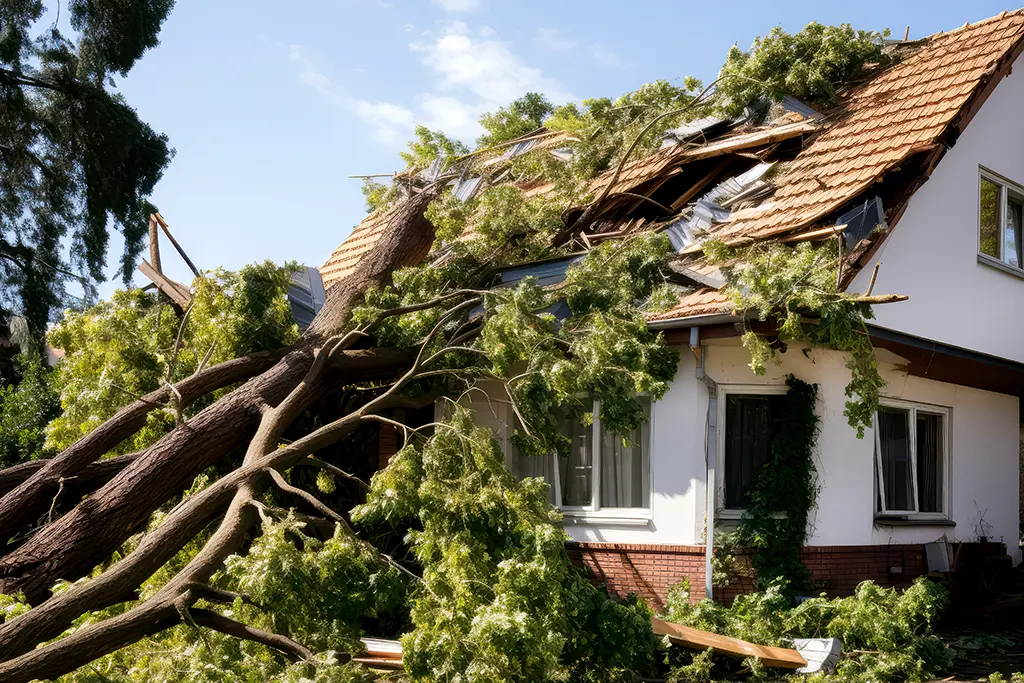


Storm Damage Insurance Claims – Storms can leave a trail of destruction, turning your property and peace of mind upside down. In the UK, where extreme weather events are becoming increasingly common, understanding storm damage insurance claims is more crucial than ever. With record claims reaching £573 million a year, knowing how to protect your property and secure compensation is essential.
This guide equips homeowners, property managers, and business owners with actionable insights into storm damage insurance claims. From understanding policy coverage to avoiding common pitfalls, you’ll find practical advice to understand the claims process confidently and prepare for future storms.
Storm Bert struck the UK in late November 2024, causing significant disruption and damage across the country.
Rainfall and Wind
– White Barrow in Devon recorded the highest rainfall, with 175.7mm falling between midnight on 23 November and midnight on 25 November.
– Treherbert, Tyn-Y-Waun in South Wales saw 171.6mm of rainfall.
– Wind gusts reached 82mph at Capel Curig in Gwynedd.
Flooding and Property Damage
– By Monday morning following the storm, over 300 flood warnings and alerts were in effect across England and Wales .
– The Environment Agency estimated around 100 properties were flooded in England.
– In Merthyr Tydfil, over 70 properties were affected by flooding.
– Across England, approximately 80 properties were confirmed to have been flooded, while flood defences protected an estimated 23,000 properties.
Fatalities and Evacuations
– At least five people lost their lives due to storm-related incidents.
– Evacuations were necessary in areas such as Blaenau Gwent and Powys due to landslides and rising floodwaters.
Infrastructure Impact
– Major rail routes, including those linking London to Wales and the southwest, were closed due to flooding and fallen trees.
– Services to Gatwick and Stansted airports were affected, with hundreds of flights cancelled over the weekend.
– Key roads, such as the M32 in Bristol and the A5 in Northamptonshire, were closed due to severe flooding.
Economic Impact
– Weather-related home insurance claims in the UK reached a record high of £573 million in 2023, a 36% increase from 2022, largely due to severe storms like Storm Bert.
Local Impacts
– In South Wales, a major incident was declared in the Rhondda Cynon Taf region, with between 200 and 300 properties affected by flooding[4].
– Four landslips occurred in Merthyr Tydfil: two in Pontsticill, one in Pontsarn, and one in Quaker’s Yard, leading to road closures.
Response and Support
– The UK government and local authorities implemented various support measures, including:
– A Local Authority Hardship Scheme offering £1,000 to each affected household and business in Merthyr Tydfil.
– The Welsh Government Discretionary Assistance Fund (DAF) provides grants to those affected by floods.
Storm Bert highlighted the UK’s increasing vulnerability to extreme weather events and the need for continued investment in flood defences and climate resilience measures. This also highlights a need for clear and concise storm damage insurance claims guidelines to help when disaster strikes.
Storms in the UK are becoming more frequent and severe, thanks to shifting weather patterns and climate change. According to recent data from Aviva, over one-fifth (22%) of UK homes have experienced storm damage in the last five years. With insurance claims for storm damage reaching a record £573 million in 2023, these events are a growing concern.
Storm damage insurance claims allow property owners to seek reimbursement for repairs or losses sustained during a storm, such as damage to roofs, windows, or outdoor structures caused by wind, hail, or falling debris. Flooding caused by heavy rain can also, in some cases, fall under storm damage.
Whether you’re a homeowner, property manager, or business owner, having a comprehensive storm damage insurance policy is crucial in safeguarding your financial future.
Before disaster strikes, one of the most important steps is thoroughly understanding your home or business insurance policy. Here’s what to look for:
Reading the fine print is essential. If policy terms are unclear, consider consulting an insurance advisor or loss assessor to clarify your rights and get the right help with you storm damage insurance claims.
What Oakleafe Clients Say:

Preparation is the best defence against future storms and will help you build a stronger case when filing an insurance claim.
Understanding the claims process can reduce stress and help you secure the compensation you deserve. Here’s how to go about it:

Filing a storm damage claim can be tricky, with several potential challenges to watch out for:
If your claim is denied or you encounter challenges, involving a professional can make a significant difference. Here are your options:
Prevention is always better than cure. Here’s how you can fortify your home or business against future storms:
Storm damage is inevitable for UK property owners, but being well-prepared can make a significant difference. You can increase your chances of a successful claim by understanding your insurance policy, maintaining thorough documentation, and acting swiftly after a storm.
Key Takeaways:
Storms may be unpredictable, but your response doesn’t have to be. Take control by staying informed, investing in preventive measures, and seeking expert guidance when necessary.
For tailored advice and professional support, connect with trusted loss assessors Oakleafe Claims.
Oakleafe Claims have represented policyholders and managed their insurance claims since before the First World War. We have vast expertise and experience in both domestic and commercial insurance claims with thousands of satisfied policyholders who have received their deserved insurance settlement.
What Oakleafe Clients Say:



Please complete the form and one of our insurance claim professionals will call you back ASAP